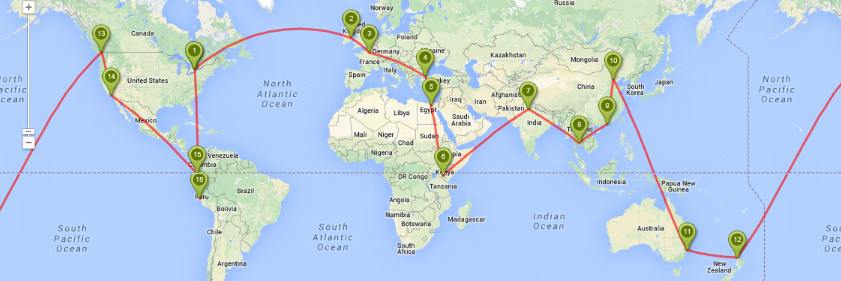While in Mumbai, we decided to visit the Elephanta Island and caves because we heard they were very interesting to see.
To reach the island, we took an hour ferry from the Gateway to India. When we arrived, we climbed stairs lined with souvenir shops selling jewelry, paintings, small statues, and more. If you can’t climb the stairs, that’s okay. There are men who carry people up on chairs called dolis. It was an interesting sight to see!
The first and most important cave was used as a temple for the cult of the Hindu god Shiva. No one is entirely sure who carved the temple or when, although some say it was during the 5-8th century AD. During the 16th century, the Portuguese were on the island and discovered a giant elephant sculpture which gave the island its name. The soldiers also unfortunately destroyed some of the carvings which they used for target practice. Today, the Elephanta caves are a UNESCO World Heritage Site and are visited by many.

There are 7 caves on the island, but the first cave is the most spectacular with a lot of carvings and shrines.There are many panels inside the cave, each depicting a scene from the life of Shiva. There are a lot of figures in the different panels, so I’m really glad we had a guide book because we wouldn’t understand what was happening. Here are descriptions and the stories about my favourite panels.
Mahesamurti
Looking straight through the rows of columns, one can see the most famous and impressive panel in the whole cave, called the Mahesamurti. It shows Shiva with three heads each representing his different manifestations.


The face in the middle has big lips and many necklaces. This manifestation is called Tatpursha or Mahadeva.
The face on the left is called Aghora or Bhairava. It is Shiva’s manifestation as the destroyer, who ends time and death. This face has a big forehead, a hooked nose, and a moustache which looks very sinister in the shadows. Symbols of death, a skull and serpents are in his hair.
The face to the right is called Vamadeva or Uma. This is the feminine aspect of creation. She has a beautiful face with a calm expression. Pearls, flowers, and leaves decorate her hair.
Kalyanasundara Murti
This panel show the marriage of Shiva to Parvati. Parvati is being pushed by her father towards Shiva as he is giving her away for marriage. She is on the god’s right which means they haven’t been married yet because as a bride, Parvati will stand to Shiva’s left. This reminds me of the Indian wedding we attended in New Delhi, because there was a lot of people attending both weddings.

Gangadhara-Shiva
According to legend, the goddess Ganga was created from the sweat of the god Vishnu which was collected by the god Brahma and put in a water container. A king Bhagiratha discovered his ancestors couldn’t go to heaven until their ashes were purified by the water, so he asked the river to come down from heaven. The river agreed, but needed someone to be underneath to break the force of its descent. The king then asked Shiva to help, which the god did by receiving the river on his head. The river flowed through Shiva’s hair onto the earth and Bhagiratha’s ancestors were accepted into heaven.
The panel in the cave shows the moment right before the river lands on Shiva’s head. It is said his wife Parvati who stands beside him, was jealous that Shiva gave the river goddess shelter. I like this panel because it has an interesting story which explains why the Ganges River is so holy.

Although I am only highlighting three of the panels, there were many more spectacular ones as well!
These carvings remind me of the ones we saw in Petra at the Treasury because they each have a story to tell. I really enjoyed visiting the Elephanta Caves and I’m glad it is a UNESCO Site so it can never be destroyed and will hopefully last for generations.


















Comments
4 responses to “Elephanta Caves…. Without Elephants!”
Hi Mik,
Thanks for the commentary and the great photos! I agree with you, that I’m glad it is a UNESCO Site and can never be destroyed! Love Baba
Hi Baba,
I loved visiting the caves because they were amazing to look at and were cool inside, as it was hot outside!
So frustrating not knowing who carved these amazing things or when…. some of these tales are a bit ‘over the top’ as were the tales in Egypt. Margaret Whewall and I would at times roll our eyes at the stories and wonder how the people came to actually believe them! But at the end of the day, I supposes that these were all Gods, and as Gods, anything was possible? But they sure make for good stories!
Hello Herta,
I love reading or learning about the different stories from mythology as they are really entertaining and give us a look at life during those times. I wish I knew who carved the caves!